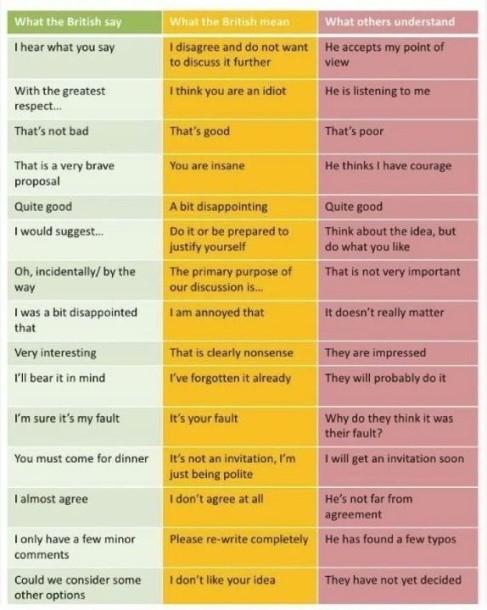During wool week I had a very interesting discussion with a Dutch lady about how we are perceived by others. She said that the British are liars and the Dutch are rude. She stated that the British are so polite that they say something is ‘lovely’ while the Dutch would rather be honest and say ‘I don’t like it’. I have to say that I couldn’t really argue – I often find myself saying one thing while thinking another. It might be interesting to have a discussion where you are only allowed to contribute if your statement is true! I found this on the internet but can’t confirm the source as the blog has been removed:
Tag Archives: conversation
Assignment 3
Introducing an element of exchange to a conversation:
Plan:
To have a conversation with the local knitting group using a knitting based question.
I planned to introduce the ‘question’ and then to mostly observe the interaction with a view to how I would record it if I were documenting.
Background: The knitting group is an informal group who get together to knit and socialise. The group consists of around 16 people ranging in age from 8 – 80 (the core group (about 10) meet every week and others come and go). The meetings last for around 2 hours on a Friday afternoon.
I planned to ask a simple knitting question and to observe the exchange between the knitters. (novice to expert)
Execute/Act: During a natural break in the conversation I asked the best way to knit a rib. I didn’t want to highlight that this was a college assignment – I wanted to keep it as natural as possible.
The resulting conversation was a lively exchange of ideas (use two needles then sew up once completed, to using 3 needles and knitting the rib ‘in the round’) The experts illustrated their conversations with demonstrations, the novices shared what they found difficult about knitting a rib-in-the-round (ie getting a ‘ladder’) and the experts shared tips on how to avoid the ‘ladder’. Some suggested starting each row with a purl to keep it tight, while others suggested passing the last 2 stitches onto the next needle to knit in a ‘spiral’.
Review: Everyone who took part seemed engaged – perhaps this was because there was a common aim and interest – it was a question with a definite response. There was a lot of movement (we were sitting around a large table and people moved from their seats to view the ‘demonstrations’ clearly.) There were very few interruptions (any interruptions were usually to ask for clarification or for repeat) The school children were keen to learn and keen to show what they were doing. My interpretation was that everyone learned something.
Reflect:
Positives:
- The group was there through choice and were willing to explore and learn from each other.
- There was a clear directive – to discuss a particular point – which kept diversions and digressions to a minimum.
- Everyone was willing to share – the group have been meeting for around 2 years – so they know each other and the ‘trust’ and confidence needed to share successfully was already there.
Points to consider:
- If /How the dynamic would have changed if they had known it was for an assignment.
- How recording would have affected responses – would they have been more reticent? More formal?
- How would response have changed if the question had been unrelated to the common interest?
- What would have happened if the question was still about knitting but had required a more personal response?
Weaknesses:
- I didn’t direct the conversation after the initial question, I was more of an observer than a participant. (I personally learned a lot from the responses- but didn’t contribute in any significant way)
- How do you gauge what others learned from the conversation? Perhaps ask them next week if they have tried any of the alternative suggestions?
- How would I have recorded this conversation? Notes? Photos? Video? Diagrams?
What have I learned?
My plan was to view the conversation while thinking how I would record it and I found this difficult.What exactly would I want to record? I need to think about an aspect I want to record – narrow it down and focus in. If I wanted to record how to knit a rib that would involve a certain type of record, if I wanted to record how people interacted – that would be different again. I think I have learned that recording a whole conversation may not be necessary or desirable.
Peter Crawley | Stitched Illustrations
Peter Crawley | Stitched Illustrations.
These are soundwaves from songs – but could this be a way of
recording a conversation?
Tino Sehgal
Tino Sehgal
‘There’s too much stuff in the world—that’s the contention of Tino Sehgal. So The Berlin-based artist constructs experiences, not objects, that can nevertheless be bought and sold.’
‘For This situation, his first New York show, at the Marian Goodman gallery in 2007, hired players started a conversation by calling out one of 100 prechosen philosophical maxims—for instance, “In 1670, somebody said: ‘True eloquence has no use for eloquence.’” They interrupted themselves to announce to new visitors, “Welcome to This situation”; to periodically demand of a viewer, “What do you think?”; or to intermittently strike poses from famous works of art.’
Above quotes taken from link below:
http://www.wmagazine.com/culture/art-and-design/2009/11/tino_sehgal/
Perhaps elements of this could inject a new dynamic to the next conversational task!
For reference
This week’s assignment…
Last week we had to:
- think of a question
- engage 2 or 3 others in conversation about it for 15 minutes.
I used the statement – ‘We don’t see things as they are, we see things as we are.’ Anaïs Nin
I assumed we would discuss my interpretation of that statement – as I hadn’t really considered there would be differing ideas of meaning – Lesson 1!
As a teacher, I am very aware of ‘co-operative learning’ which was delivered through Chris Ward at a 3 day Shetland Inservice Training Course. (see below)
The idea behind group discussion revolves around everyone taking part – one of the key points is to allow everyone to speak in turn in the initial 5 minutes (usually on something unrelated to the topic) to allow everyone to feel at ease and to prevent the barriers that can arise in normal conversation when you haven’t contributed. The longer you say nothing the harder it is to say something.
A second key point is seating arrangement – groups of 4 should have two people facing each other and groups of 3 should be in a triangular formation – this promotes easier flow of dialogue.
Personal Reflection: You are not a teacher out of school – so no need for the ‘teacher voice’! (Lesson 2)
I know cooperative learning is aimed at schools and other educational institutes but I feel it can be successfully applied in all areas where groups with ‘common aims’ come together.
Links and info on co-operative learning:
What is co-operative learning? http://www.co-operation.org/home/introduction-to-cooperative-learning/

